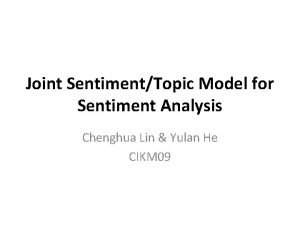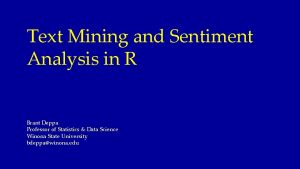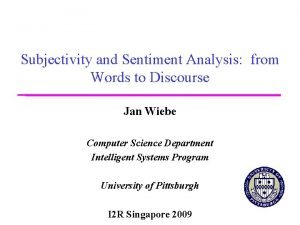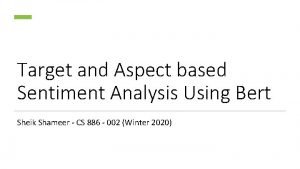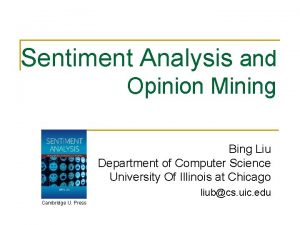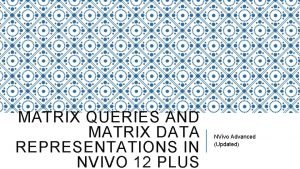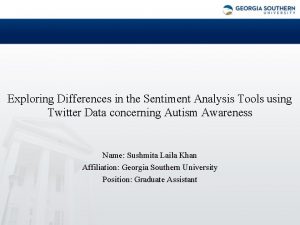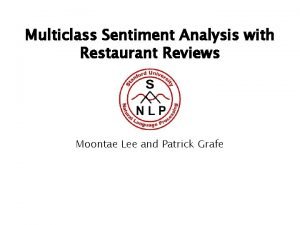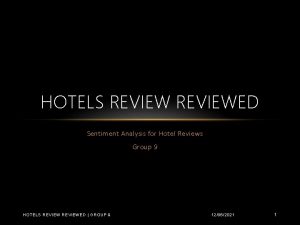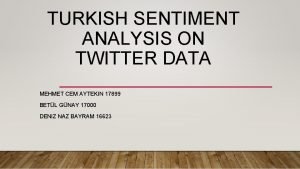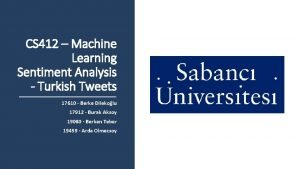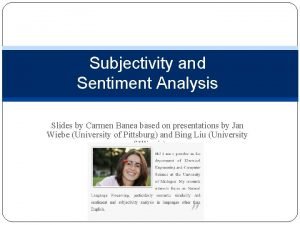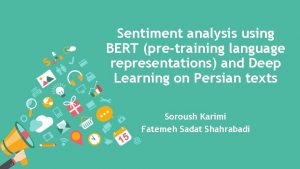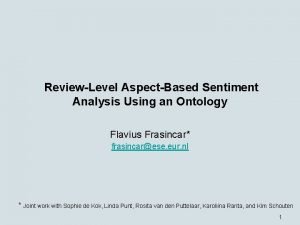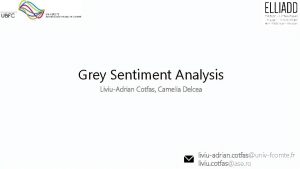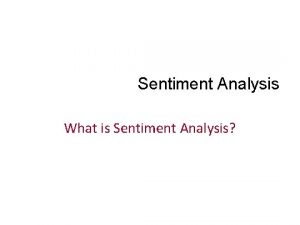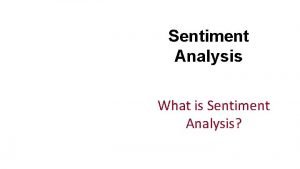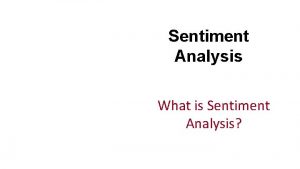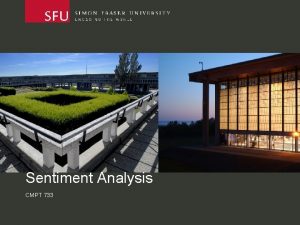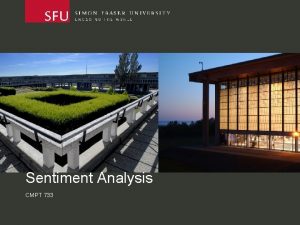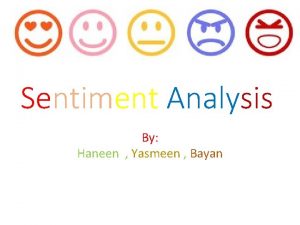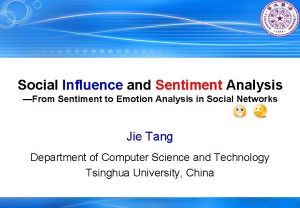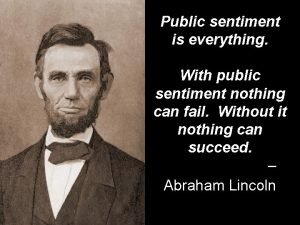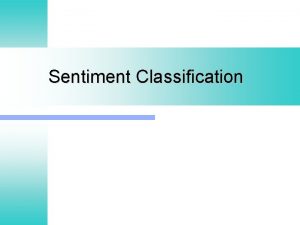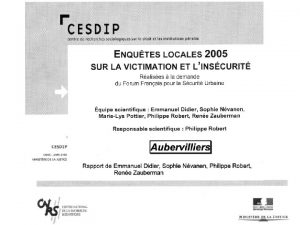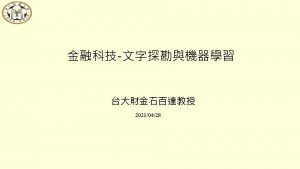Interactive MultiGrained Joint Model for Targeted Sentiment Analysis







![Two layer Bi-GRU sentence x =[x 1, x 2, . . . , xn], Two layer Bi-GRU sentence x =[x 1, x 2, . . . , xn],](https://slidetodoc.com/presentation_image_h2/4f1c6cbdd9df7826d08378c5c3a5f701/image-8.jpg)

![● sentence x =[x 1, x 2, . . . , xn], xi ∈ ● sentence x =[x 1, x 2, . . . , xn], xi ∈](https://slidetodoc.com/presentation_image_h2/4f1c6cbdd9df7826d08378c5c3a5f701/image-10.jpg)









- Slides: 19

Interactive Multi-Grained Joint Model for Targeted Sentiment Analysis Advisor: Jia-Ling Koh Presenter: Cheng-Wei Chen Source: CIKM’ 19 Data: 2020/12/1 1

●Introduction Outline ●Method ●Experiments(with conclusion) 2

●Introduction Outline ●Target ●Previous work ●Change in this paper 3

Target ● Give a sentence x =[x 1, x 2, . . . , xn], xi ∈ Rdw, we want to do targeted sentiment analysis and get two tagging sequences: 1. y. T=[y. T 1 , y. T 2 , . . . , y. Tn ] for target extraction 2. y. S = [y. S 1 , y. S 2 , . . . , y. Sn ] for target-based sentiment classification. 3. The number of target extraction labels and sentiment classification labels are Ctar and Csen ● Ex: Feel so sad about Whitney Houston. (as above) Use BIO scheme(Labeling task) with named entity types (e. g. person and organization) sentiment polarity types (e. g. positive, negative and neutral). 4

Previous work ● Pay more attention to either target extraction or sentiment classification independently Pipeline method was the usual way in the past, but Cannot fully take advantage of the mutual benefits of the two subtasks 5

New change in this paper ●Joint method(Modified) ● Care about relations between Target extraction and sentiment classification. ● By finding which words are modified by sentiment clues, the model could extract targets more accurately. ● Alleviate the overlap of two kinds of roles. (Two kinds of loss) 6

●Method Outline ●Architecture ●Coarse-grained ●Interaction ●Fine-grained ●Loss function 7
![Two layer BiGRU sentence x x 1 x 2 xn Two layer Bi-GRU sentence x =[x 1, x 2, . . . , xn],](https://slidetodoc.com/presentation_image_h2/4f1c6cbdd9df7826d08378c5c3a5f701/image-8.jpg)
Two layer Bi-GRU sentence x =[x 1, x 2, . . . , xn], xi ∈ Rdw CNN sentence ch =[ch 1, ch 2, . . . , chn], chi ∈ Rdch Architecture Concatenate two embedding and do Bi-GRU Find probability inferring to a part of target and a sentiment clue Design an interaction mechanism to build information exchange process between target and their corresponding sentiment clues. 8

Learn specific gravity & use CRF to model the dependencies between labels Architecture Learn specific gravity & use CRF to model the dependencies between labels 9
![sentence x x 1 x 2 xn xi ● sentence x =[x 1, x 2, . . . , xn], xi ∈](https://slidetodoc.com/presentation_image_h2/4f1c6cbdd9df7826d08378c5c3a5f701/image-10.jpg)
● sentence x =[x 1, x 2, . . . , xn], xi ∈ Rdw ● sentence ch =[ch 1, ch 2, . . . , chn], chi ∈ Rdch ● Concatenate two embedding and do Bi-GRU=> hi ● dh = 2(dw + dch) Coarsegrained Probability means whether a word belongs to a target or sentiment clue or not. Where Wz , Wq ∈ R 2×dh are weight matrices. 10

● A. Sentiment clue information to target tagging information: Interaction (Attention Value) Ex: If 1. ‘sad’ is predicted as a sentiment clue. (high z. Sj) 2. ‘Houston’ is highly linked to ‘sad’. (high Ai, j) =>‘Houston’ has a high possibility of being a target. 11

● A. Sentiment clue information to target tagging information: Interaction Gate mechanism Wg ∈ Rdb×db and Wtrans ∈ Rdb×da 12

● B. Target tagging information to sentiment tagging information: Interaction att. Si ∈ RCsen is the attention-based sentiment tagging information. 13

Fine-grained h i => h i′ (Bi-GRU) Conditional random fields 14


Loss function 16

● 資料集 Experiments 17

Experiments (With other method) (W/O partial work) 18

Experiments (W/O loss and different parameter) 19
 Joint sentiment topic model for sentiment analysis
Joint sentiment topic model for sentiment analysis Spark streaming twitter sentiment analysis
Spark streaming twitter sentiment analysis W62vr
W62vr Subjectivity in sentiment analysis
Subjectivity in sentiment analysis Sentihood
Sentihood Opinion definition
Opinion definition Sentiment analysis nvivo
Sentiment analysis nvivo Sentiment analysis tools comparison
Sentiment analysis tools comparison Sentiment analysis of restaurant reviews
Sentiment analysis of restaurant reviews Sentiment analysis for hotel reviews
Sentiment analysis for hotel reviews Turkish sentiment analysis
Turkish sentiment analysis Turkish sentiment analysis
Turkish sentiment analysis Azure twitter sentiment analysis
Azure twitter sentiment analysis Slide to doc.com
Slide to doc.com Nbsvm
Nbsvm Sentiment analysis conclusion
Sentiment analysis conclusion Liviu cotfas
Liviu cotfas Linear interactional and transactional
Linear interactional and transactional First and earliest model of communication
First and earliest model of communication Targeted youth support islington
Targeted youth support islington
